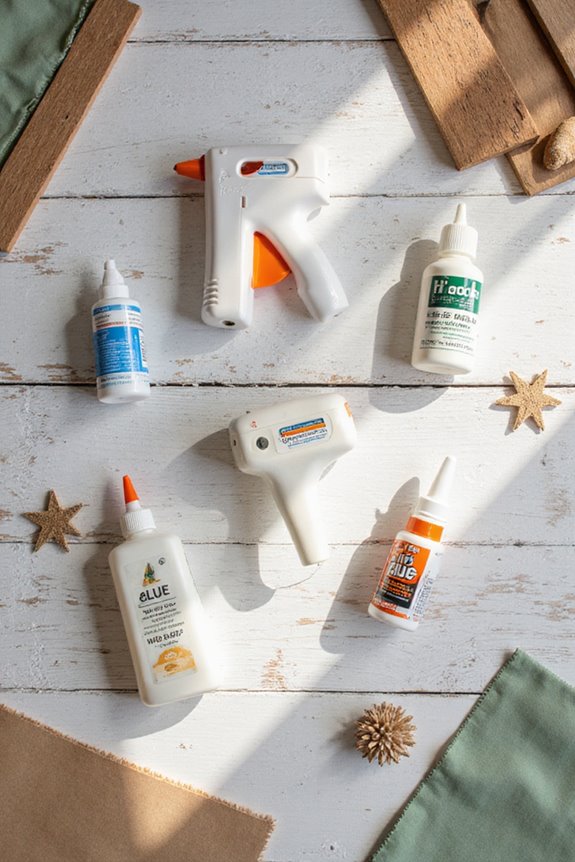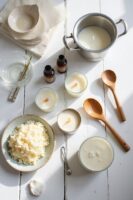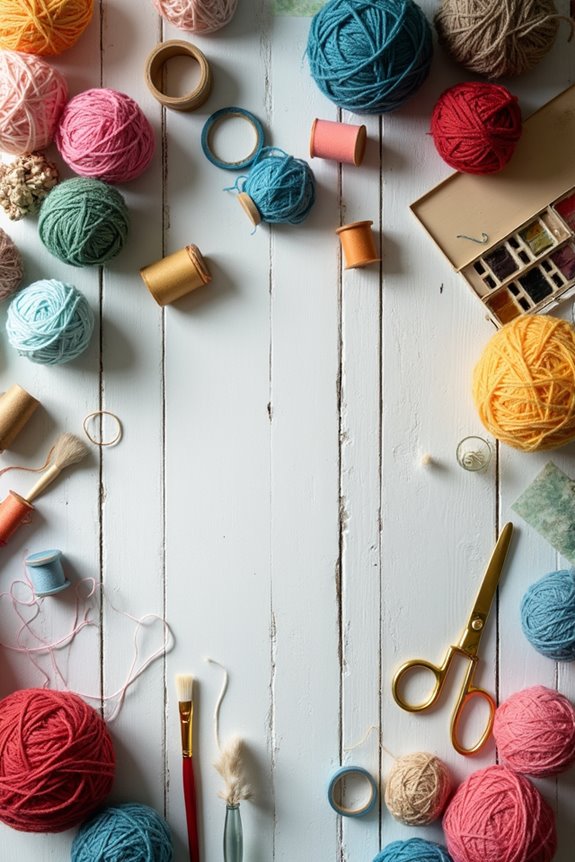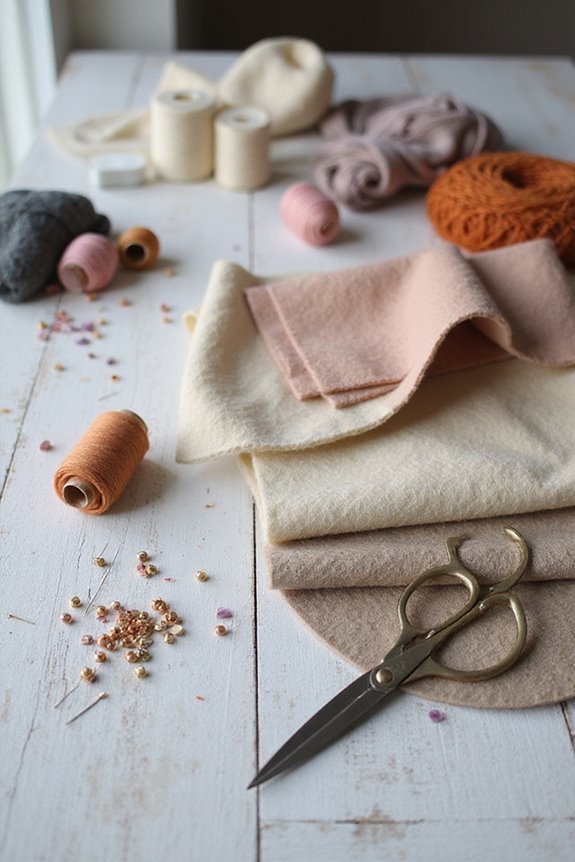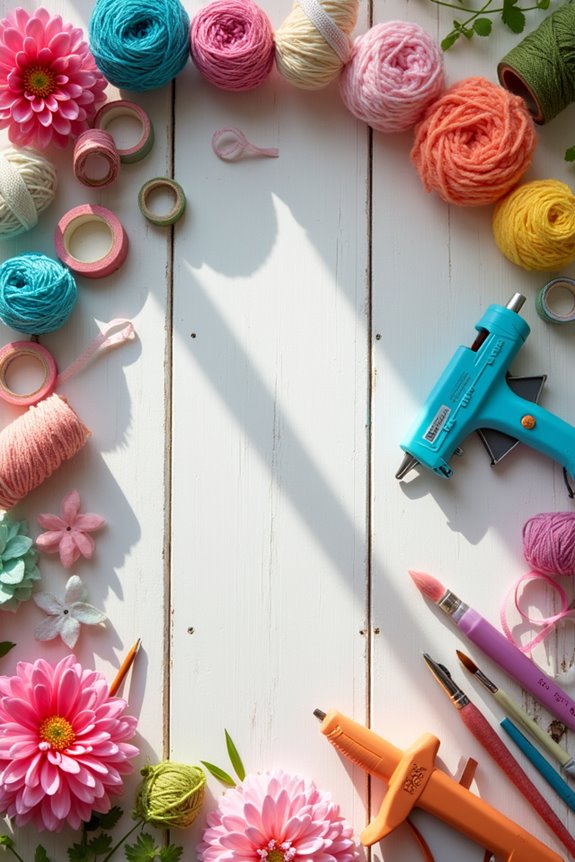Choosing the right glue for different craft materials can really make a difference in your projects. 🛠 For paper and cardstock, tape runners or precision glue pens are best. For wood, PVA glue or epoxy works wonders. Fabric calls for something strong like Aleene’s Fabric Fusion or Gorilla Fabric Glue. Don’t forget to reflect on drying times! ⏳ If you want to master glue techniques for other materials, we’ve got plenty more tips coming up!
Key Takeaways
- Identify the materials you are working with to select a compatible adhesive, such as PVA glue for wood and fabric.
- Consider the specific project’s requirements, including drying times and water resistance; epoxy is great for strong, waterproof bonds.
- For paper and cardstock, use tape runners or precision glue pens to minimize warping and control application.
- Choose fabric adhesives like Aleene’s Fabric Fusion for permanent bonds or Tear Mender for waterproofing on outdoor textiles.
- Always prioritize health and safety by using gloves, working in a ventilated space, and keeping adhesives properly stored.
Understanding Different Types of Glue
When we talk about glue for crafts, it can feel a bit overwhelming with all the options available. Let’s break it down!
- PVA Glue: Great for wood and fabric, it dries clear and is non-toxic. Perfect for indoor work.
- Tacky Glue: This is a versatile adhesive that works on various materials like foam and cardboard, drying clear and odorless.
- Hot Glue: If you need rapid adhesion, this is your go-to. Just remember, it’s not for heat-sensitive items and has quick heating times for efficient crafting.
- Specialty Adhesives: Like epoxy, they give you super strong, water-resistant bonds for tougher materials.
With a glue properties comparison, we can see their adhesive drying times differ, so pick based on your project needs!
Choosing Glue for Paper and Cardstock
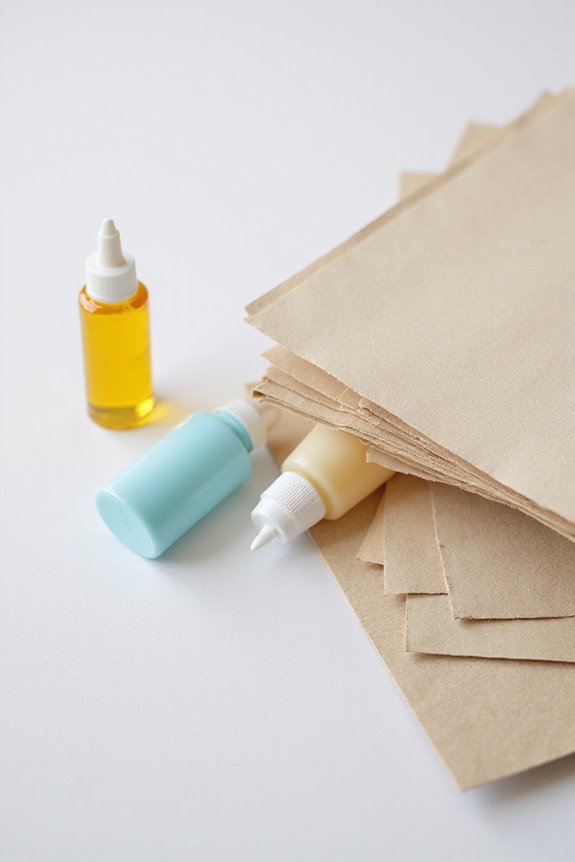
Choosing the right glue for paper and cardstock can make all the difference in your crafting projects, especially if we want to avoid any unwanted warping. Different paper weights absorb adhesives uniquely, so knowing the right adhesive types is essential.
- Tape runners offer mess-free application with minimal warping.
- Precision glue pens apply tiny dots, preventing paper soak and buckling.
- Liquid glues can warp if used excessively but excel in intricate cuts.
To optimize adhesion, apply glue in small dots or thin lines, allowing adequate drying time between layers. For delicate papers, use acid-free adhesives to avoid damage. Additionally, consider the bonding strength of the adhesive to ensure a secure hold without compromising the paper’s integrity. Finally, store glue in cool, dry places for best performance!
Selecting Adhesives for Wood Projects
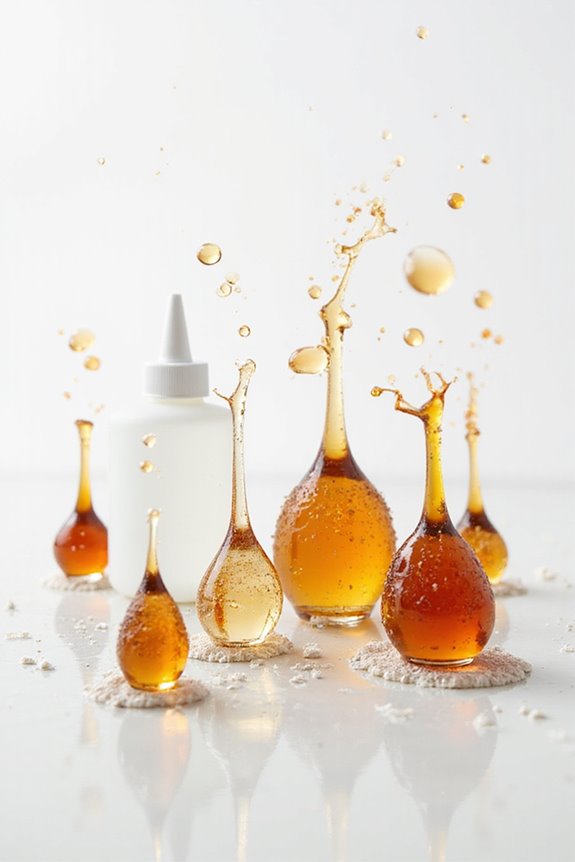
Selecting the right adhesive for wood projects can feel overwhelming, especially with the variety of bonds available. For most indoor woodworking, PVA glue is our go-to option thanks to its reliability and strength. 🛠 It not only creates bonds stronger than the wood itself but also cleans up easily with water.
For more demanding applications, epoxy adhesives come into play. These are perfect for filling gaps and cracks, guaranteeing a robust bond even when surfaces don’t align perfectly. When using them, we can achieve durable results that withstand heavy usage. Additionally, soldering iron kits can be beneficial for wood projects that require heat-sensitive applications, allowing for versatile crafting techniques.
Tips for Success:
- Always clamp joints for 20-30 minutes for peak strength.
- Verify surfaces are planed smooth for better adhesion.
Best Glues for Fabric and Textiles
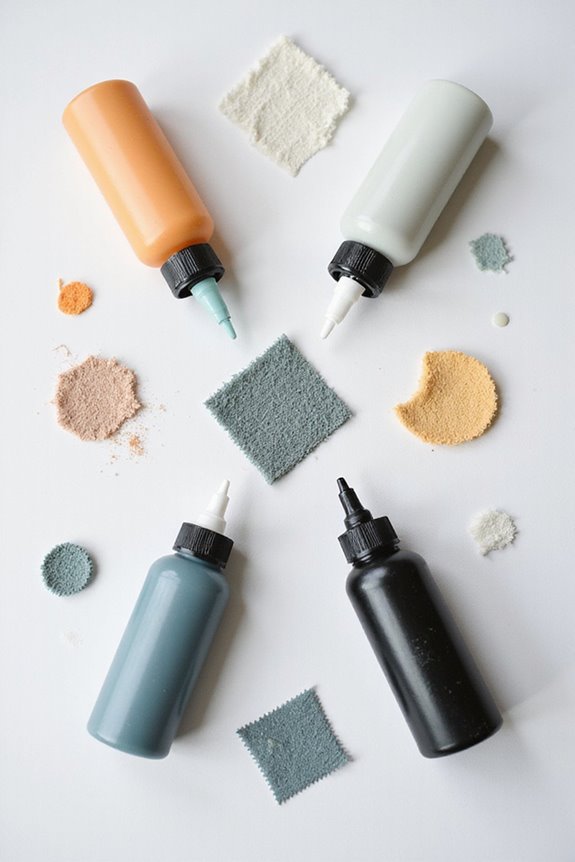
Finding the right glue for fabric and textiles can often feel like an intimidating task, especially with so many options available. Let’s explore the best fabric glue types for your projects!
- Aleene’s Fabric Fusion: Offers strong, permanent bonds—great for durable fabric needs.
- Tear Mender: Ideal for outdoor projects with its waterproof and UV-resistant properties.
- Elmer’s CraftBond: Perfect for quick fixes, drying fast while holding strong.
- Gorilla Fabric Glue: Flexible and strong, it works well across various textiles.
- E6000: Best for heavy-duty fabrics but has a longer drying time.
When choosing, consider fabric glue properties like drying speed, flexibility, and washability to guarantee your creations last! 🧵✨ Additionally, it’s important to consider non-toxic, water-based formulas that are safe for use, especially in projects involving children.
Adhesives Suitable for Plastic Materials
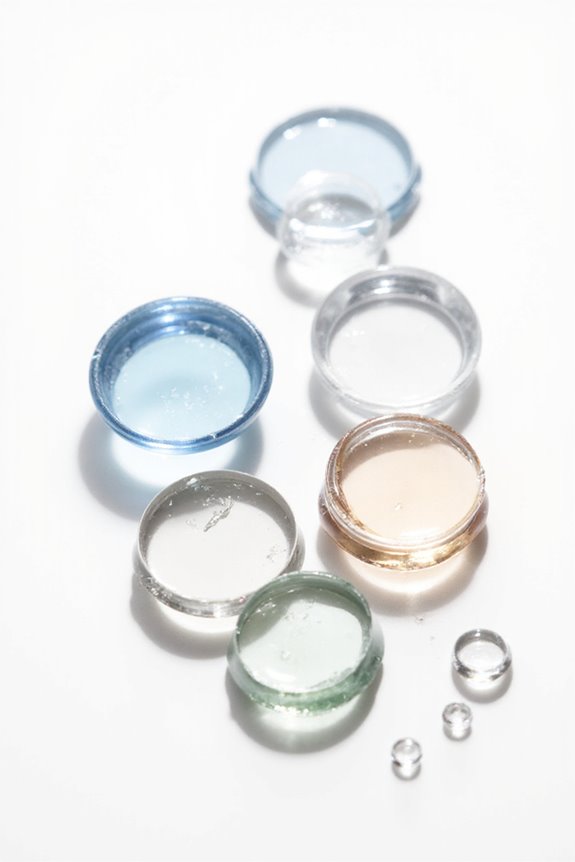
When it comes to working with plastic materials, there are several important factors to contemplate for achieving strong bonds. For plastic bonding, we need specialized adhesive types, especially for low surface energy plastics like polyethylene (PE) and polypropylene (PP).
Here are some top options:
- SuperTAC 500: Great for PE and PP, it’s a hot melt glue stick that works well under extreme temperatures. 🔥
- Infinity Bond MMA 500: A two-part adhesive that guarantees permanent bonds, perfect for tricky plastics.
- Loctite AA 3035: This acrylic adhesive cures at room temperature, offering a quick, effective solution. Additionally, understanding mixing ratio importance is crucial for ensuring optimal adhesive performance in various applications.
Effective Glues for Metal and Ceramic
Choosing the right glue for metal and ceramic projects can seem tricky, but we’ve got you covered! For strong and durable bonds, we recommend epoxy adhesives due to their epoxy advantages. They create a tough, long-lasting bond that can handle vibration and temperature changes. Just remember to mix the resin and hardener carefully!
While super glue (cyanoacrylate) is great for quick fixes, it has super glue limitations. It works best on smooth surfaces and can’t fill gaps effectively, so joints need to fit tightly.
🛠 Tips for success:
- Clean surfaces to remove oils or dust.
- Roughen surfaces with fine-grit sandpaper for better adhesion.
- Apply glue evenly to avoid weak spots.
Now you’re ready to tackle those metal and ceramic projects!
Considering Drying Times and Finishes
How can we guarantee our crafts turn out just right? Understanding drying times and glue finishes is key! Here are some important tips:
- Set Time vs. Cure Time: Set time is how long we can reposition pieces, while cure time is when the glue reaches full strength—often a full 24 hours for best results.
- Choosing Drying Times: For intricate projects, longer set times let us adjust pieces. Quick drying glues work well for speedy projects, but require precision.
- Glue Finishes: Look for glues that dry clear to avoid a milky residue on visible surfaces. Some glues dry glossy, impacting appearance.
- Tip: Always test the glue on scrap material first to see how it dries! 🖌
Health and Safety Precautions in Crafting
Crafting can be a fun and rewarding hobby, but it’s essential to prioritize health and safety. Let’s make sure we’re using safety equipment like gloves and safety goggles when handling glue. These protect us from eye and skin irritation, which some adhesives can cause.
We should also work in areas with proper ventilation to prevent inhaling harmful fumes. Keeping our space clean helps, too—remember to wash hands thoroughly after use.
As we store our adhesives, let’s keep them away from heat sources and tightly closed to minimize hazards. If we follow these precautions, we can enjoy our crafting activities without compromising safety. 🛠 Always refer to Safety Data Sheets for specific handling instructions, and stay safe! ✨
Tips for Applying Craft Glue Properly
Here are some useful tips for glue application:
- Use fine brushes for delicate surfaces.
- Apply small dots or thin lines to minimize drying time.
- Wipe excess glue promptly to prevent residue.
Before we glue, verify surfaces are clean and dry for strong adhesion. Leveraging the right tools and techniques, we can create beautiful projects while guaranteeing a professional finish. Let’s enhance our craftsmanship with careful application! 🧡
Frequently Asked Questions
Can I Mix Different Types of Glue Together?
We shouldn’t mix different types of glue together. Glue compatibility matters, and mixing adhesives can result in unpredictable bond strength and safety hazards. It’s best to follow manufacturer guidelines for ideal performance and safety.
What Glue Is Best for Outdoor Projects?
When tackling outdoor projects, we should focus on weather resistant adhesives like waterproof silicone sealants and epoxy glues. These outdoor crafting supplies guarantee lasting bonds, even in extreme conditions, making our creations durable and beautiful year-round.
How Can I Remove Dried Glue From Surfaces?
Like a painter restoring a canvas, we can master glue removal techniques to reveal the beauty beneath. We’ll focus on gentle methods, ensuring surface damage prevention while gracefully resuscitating our cherished objects. Let’s get to work!
Are There Eco-Friendly Glue Options Available?
We can certainly find eco-friendly glue options! Biodegradable adhesives and natural alternatives made from plant-based materials are not only effective but also safe for the environment, helping us craft responsibly while minimizing our ecological footprint.
Does Glue Lose Its Strength Over Time?
Yes, glue does lose strength over time. We should consider glue longevity factors, like environmental conditions and adhesive aging effects, as they greatly influence the durability and reliability of our chosen adhesives in projects.

